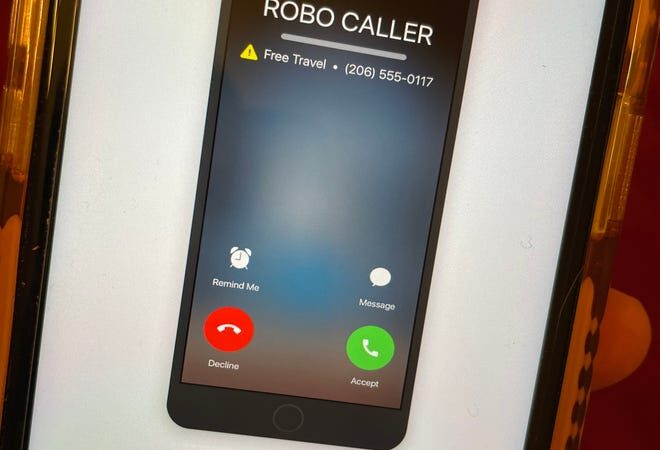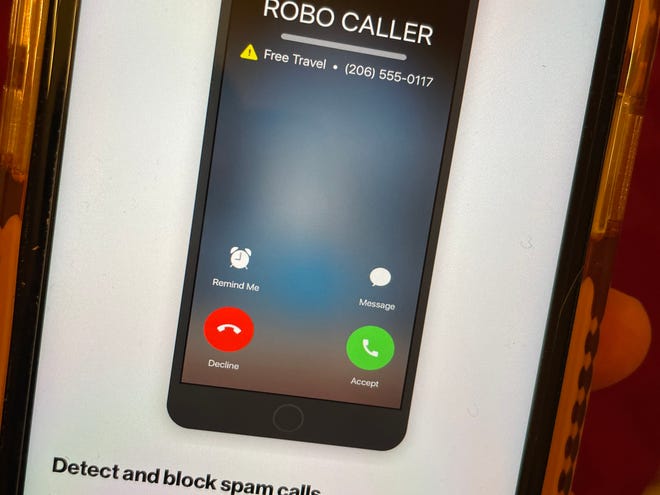
You pick up the phone and hear, “We’ve been trying to reach you concerning your vehicle’s extended warranty.” It’s a pre-recorded message, and it instructs you to press a certain number or stay on the line.
Don’t fall for it. It’s probably a scam.
More than 2 million individual consumer complaints have been filed in the past eight years with the Consumer Help Center from the Federal Communications Commission, which handles a wide range of telecommunications service and billing issues.
Unwanted calls are the single largest source for those complaints.
At least 55% of all the reports filed to the FCC are due to unwanted calls, including telemarketing and robocalls, according to a USA TODAY analysis.
See if someone’s complained about a number
If you cannot see a data search tool below, click here.
The searchable database above reflects 808,342 unwanted calls consumers reported to the FCC in the past eight years.
Those represent only 60% of all unwanted call complaints because many phone customers did not report a number from caller ID. Factoring in repeats for the same phone line, the database contains 551,345 unique numbers.
Being listed in the database doesn’t necessarily mean a caller is up to no good. The FCC doesn’t investigate or resolve those individual complaints but instead uses them to help inform FCC enforcement and policy work.
Nonetheless, a robocall trying to sell something via consumers’ wireless or wireline phones is always illegal unless the company has obtained written or oral permission from them. There are only a few exceptions such as emergency calls regarding danger to life or safety that are made to either wireless or landline numbers, or market research, or polling calls via wireline numbers only.
More unwanted call reports are kept by the Federal Trade Commission, which maintains a Do Not Call Registry and takes complaints.
Who is calling?
“Most of those unwanted calls are from scammers trying to defraud people and calling on behalf of IRS, DHS, and different companies or from people selling unwanted services such as car warranties,” said Ragib Hasan, tenured Associate Professor at the Department of Computer Science at the University of Alabama at Birmingham whose research is focused on cloud computing and systems security.

Since 2015, the FCC has received an annual average of 171,223 unwanted telephone call complaints. The top reason for those complaints is automobile warranty renewal robocalls. Those calls often included specific information about the user’s car and warranty that made the call seem legitimate, according to the FCC website.
Other consumer complaints received by the FCC involve lawsuits and criminal charges scam calls, social security number phishing, and insurance or healthcare-related calls.
Many of those robocalls originate overseas. In 2021, the Industry Traceback
Group reported that 65% of the voice service providers identified as transmitting illegal
robocalls were either foreign-based or gateway providers.
“Scam calls often originate overseas and route through shady telecom services,” said Jonathan Mayer, an assistant professor at Princeton University, with appointments in the Department of Computer Science.
How many calls are we talking about?
In addition to the FCC, the Federal Trade Commission takes complaints that touch on unwanted calls. The complaints taken by either agency are just the tip of the iceberg.
“Most individuals never submit a complaint to the FCC or FTC’s DoNotCall registry for violations,” Hasan said. “Either they don’t know the complaint process or they find it a hassle.”
The Federal Trade Commission’s tracking of imposter scams shows that from last January through the third quarter of 2022, it received 229,494 reports of phone call fraud, with nearly $590 million in reported money lost.
The FTC’s Do Not Call Registry allows users to register their numbers to stop sales calls from real companies. After the number is on the registry for 31 days, people can report unwanted sales calls. The Registry received 935 complaints per 100,000 people from October 2021 though September 2022, and over 60% of those were robocalls.
YouMail, a private company that provides robocall-blocking software, has created a Robocall Index that estimates monthly robocall volume It reported 4.3 billion robocalls in December alone. That is equivalent to 136.6 million calls a day and an average of 13 calls per person.
How to block spam calls and robocallers
An FCC tipsheet tells people: “If you answer the phone and the caller – or a recording – asks you to hit a button to stop getting the calls, you should just hang up.”
The government-approved way to stop unwanted calls from legitimate companies is to add your name to the FTC’s Do Not Call Registry.
Experts also recommend looking into call-blocking tools such as YouMail and RoboKiller.
Your life in data: See crucial databases that can help you make everyday decisions
Why are unwanted calls dangerous?
Recorded phone pitches don’t reach people at random, experts say.
“Some of those campaigns are extremely targeted,” said Alex Quilici, CEO of YouMail, a private company that provides robocall-blocking software. “Medicare robocall scams target 65-year-olds and over, the student loans scammers tended to call 25 to 45-year-olds, and sometimes they may even have specific lists of people that bought a particular medical device for example.”
Experts agree that scammers are likely to identify potential victims by trolling the Internet and searching for lists of people with something in common. They tend to target vulnerable people and utilize psychological mind tricks to play with their insecurities and scam them.
“Scam calls disproportionately target vulnerable populations, and I believe the most dangerous unwanted calls are those preying on a specific demographic,” said Christian Wartchow, CEO of CyberSecure IT Solutions which serves Southwest Florida. “We see an awful lot of elderly victims on a weekly basis that receives calls from impostors impersonating Amazon or Spectrum agents and stealing personal information.”
What is the FCC doing about it?
FCC has been trying to crack down on unwanted calls for years now. The agency took aggressive enforcement action against telemarketers for apparently illegal caller ID spoofing and robocalling. In addition, agency regulators required telecom services to implement forms of call authentication and to block calls from non-compliant services.
In 2017, the FCC authorized voice service providers to block certain calls that appear to be from “invalid, unallocated, or unused numbers.” Two years later, the TRACED Act was passed, requiring every provider to file a robocall mitigation plan and to verify that the caller ID information transmitted with each call matches the caller’s real phone number.
“FCC has done a lot, and we’ve seen we’re already seeing scam calls decline a little bit, which is good, said Quilici.
But the threat remains strong, said Quillici, “because scammers are getting smarter, and calls are being way more targeted.”
“Consumers,” he said, “need to take the necessary steps to protect themselves.”






